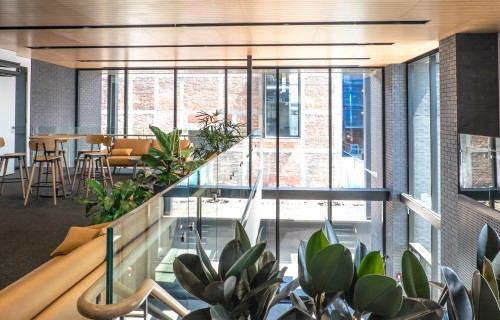Turning On the Human Impact of Energy Management

The business benefits of sustainable energy strategies are considerable. However, energy management has traditionally neglected the softer, human side of the coin: employee comfort and quality of life.
Globally, energy management has become a C-Suite issue. While we’re a long way down the road from ‘selling’ the moral and competitive advantages of sustainability into boardrooms, the impact that an energy efficient workplace can have on employee quality of life is often overlooked.
The average building wastes 30% of the energy it consumes because of inefficiencies, which is both costly and damaging to the environment. In the U.S. alone, an uplift of just 10% in the overall energy efficiency of commercial and industrial buildings would save nearly $40 billion each year in energy costs and reduce greenhouse gas emissions by the equivalent of 49 million motor vehicles.
While these numbers are compelling, the true extent to which energy efficiency can impact companies and their employees is often misunderstood. Energy commitments not only feed the mission around sustainability, they can also optimize workplace comfort, which improves employee health and drives productivity. An added benefit is that these commitments play an increasingly important role in enhancing company image and reputation.
With many organizations already taking great strides towards a greener future, businesses will need to be ambitious to keep pace with competitors and meet the expectations of employees and consumers. Business leaders must become the architects of this positive impact, making commitments to create sustainable workplaces that position employee needs at the forefront of change.
The Competitive Advantage
Energy management strategies provide companies with a competitive edge when it comes to attracting new talent and appealing to eco-conscious consumers. In the Deloitte Resources 2019 Study on Energy Management, among the top drivers for energy resource management programs were “employee motivations” (29%), "competitive advantage" (27%), and "brand enhancement" (19%). Nearly 40% of businesses said it’s “just the right thing to do.”
Companies should take note that Millennials are more concerned about energy issues than other age groups. Within their own homes, members of this demographic are more willing to pay a surcharge for cleaner energy sources, and they are also more interested in incentives for saving electricity and purchasing related technologies. Organizations who effectively engage with employees and consumers from this generation—and like-minded individuals from all generations—could open up a wealth of new business opportunities.
The Human Impact
The business and reputational benefits of sustainable energy strategies are considerable. However, energy management has traditionally neglected the softer, human side of the coin: employee comfort and quality of life. According to the National Human Activity Pattern Survey, people spend between 80-90% of their lives inside enclosed buildings. For employees, the anatomy of the workplace environment has an enormous bearing on health because, quite simply, it’s where they spend most of their time.
 For Alan Hedge, Professor of Design and Environmental Analysis at Cornell's College of Human Ecology, green building design needs to evolve. "The current emphasis is on meeting energy goals,” Hedge explains. “You can meet those, but if people are uncomfortable you’ll lose their support and their productivity. The message is, you can be green, but you also have to be human."
For Alan Hedge, Professor of Design and Environmental Analysis at Cornell's College of Human Ecology, green building design needs to evolve. "The current emphasis is on meeting energy goals,” Hedge explains. “You can meet those, but if people are uncomfortable you’ll lose their support and their productivity. The message is, you can be green, but you also have to be human."
Matt Lucas, Vice President, Global Energy Services at Sodexo, agrees. “Energy management services don’t just impact the environment,” he says. “There is a direct correlation to the quality of life of our consumers.”
"When people construct green buildings, they must pay attention to how well the buildings work from a human standpoint."
Alan HedgeCornell's College of Human Ecology
Strategies that prioritize human comfort are core to every company’s success. Behind the numbers and the sustainability metrics are thousands of human touch points, all of which have the potential to make or break an employee’s day. “Energy management increases employee efficiency and improves health and wellbeing, by making the workplace more comfortable and more pleasant,” Matt explains. “These quality of life dimensions must be central to corporate energy management roadmaps.”
Can the Workplace be Healthy and Energy Efficient?
Most employers would agree that a human-centric approach to energy management is key. But many believe that a workplace that’s both energy efficient and optimized for human comfort doesn’t exist.
This misconception couldn’t be farther from the truth. In fact, optimized systems, equipment and environments that enhance employee quality of life will also achieve important business outcomes. One study of 500 LEED (Leadership in Energy and Environmental Design) or Energy Star labeled buildings found uplift in employee productivity and wellbeing, as well as a reduction in overall absenteeism.
Further research into the four factors of indoor environment quality (IEQ)—temperature, light, noise, and air quality—demonstrates the positive impact that a healthy building can have on employees, while still being energy efficient and cost-effective:
- Temperature: Some companies adjust office temperatures to cut energy costs, but the money they lose in productivity far outweighs the savings. Employers could be paying 10% more in labor expenses when the office temperature is uncomfortable, according to a Cornell University study. IFMA research confirms that the top 2 issues that impact office workers’ ability to get work done are being “too hot” or “too cold.”
- Light: Lighting accounts for over 20% of the energy used by commercial buildings. Many businesses have achieved their energy goals partly by using natural daylight as a substitute for electrical lighting. And the benefits for employee health and productivity are compelling—natural lighting supports the body’s circadian rhythm, which improves sleeping patterns (adding up to 47 minutes more sleep per night), and it affects mood, energy levels and attention spans.
- Air Quality: Improving indoor air quality not only prevents respiratory issues, it can also increase employee productivity by 6-9%. From a cost perspective it all adds up—Harvard researchers estimate that when ventilation rates in under-ventilated buildings are doubled, at an additional cost of just $40 per person, office productivity increases by $6,500 per employee per year. Smart ventilation also prevents over-ventilation, which wastes energy and money.
- Noise: Chronic noise exposure is linked to hearing loss and hypertension, and it can decrease the accuracy of employees’ work by up to 67%. While excessive noise is sometimes the result of poor space design, it may also be a sign of inefficiencies or maintenance issues in a building’s energy systems. Addressing noise issues can therefore affect both employee quality of life and energy system efficiency and lifespan.

CASE STUDY: American Society of Interior Designers HQ, in Washington, DC, U.S.A.
ASID’s new office headquarters was designed for environmental sustainability, and health and wellness, with a focus on indoor air quality, employee satisfaction, and productivity. In their new office, employee absenteeism has decreased by 19% and presenteeism (being present at work but not productive) has decreased by 16%.
Powering the Workplace of Tomorrow, Today
From an external perspective, the purpose of sustainable energy strategies is clear: increase efficiency, save money, and contribute to a greener future. However, scratch beneath the surface and the advantages of energy management appear to be even greater.
A strong energy management strategy can give your organization a boost when it comes to appealing to today’s ecologically-minded employees and consumers. More importantly, an energy efficient workplace can help create a comfortable, exceptional environment that supports the health and productivity of your people. And after all, isn’t that what matters most?
Energy Management with Sodexo
At Sodexo, we believe it’s vital to increase awareness and deploy best practices around energy efficiency. We provide comprehensive energy benchmarking audits, and we work with trusted partners to identify processes, equipment and other assets that are energy inefficient or wasteful. Our solutions are designed to improve performance, without disrupting employees or compromising their comfort and safety.
Our expertise in energy management has helped businesses across the world to reduce energy costs and carbon emissions, and drive meaningful behavioral change through targeted analysis of assets and how they’re used.
Contact us if you’d like to learn more about our energy services or participate in an energy benchmarking audit.